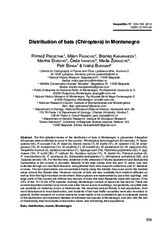Приказ основних података о документу
Distribution of bats (Chiroptera) in Montenegro
| dc.creator | Presetnik, Primož | |
| dc.creator | Paunović, Milan | |
| dc.creator | Karapandža, Branko | |
| dc.creator | Đurović, Marina | |
| dc.creator | Ivanović, Čeda | |
| dc.creator | Ždralević, Maša | |
| dc.creator | Benda, Petr | |
| dc.creator | Budinski, Ivana | |
| dc.date.accessioned | 2024-03-27T14:17:36Z | |
| dc.date.available | 2024-03-27T14:17:36Z | |
| dc.date.issued | 2014 | |
| dc.identifier.issn | 1213-6123 | |
| dc.identifier.uri | https://www.ceson.org/vespertilio/17/129_156_Presetnik.pdf | |
| dc.identifier.uri | http://radar.ibiss.bg.ac.rs/handle/123456789/6598 | |
| dc.description.abstract | The first detailed review of the distribution of bats in Montenegro is presented. Altogether 28 species were confirmed to occur in the country: Rhinolophus ferrumequinum (55 records), R. hipposideros (54), R. euryale (12), R. blasii (5), Myotis myotis (7), M. blythii (37), M. nattereri (12), M. emarginatus (12), M. mystacinus (12), M. alcathoe (1), M. brandtii (2), M. daubentonii (3), M. capaccinii (32), Vespertilio murinus (4), Eptesicus serotinus (7), Hypsugo savii (18), Pipistrellus pipistrellus (22), P. pygmaeus (19), P. kuhlii (38), P. nathusii (6), Nyctalus noctula (13), N. leisleri (4), Plecotus auritus (2), P. macrobullaris (3), P. austriacus (4), Barbastella barbastellus (1), Miniopterus schreibersii (39), and Tadarida teniotis (18). For the first time, evidence of the presence of Myotis daubentonii and Barbastella barbastellus in the country is provided. Majority of the data comes from the past 15 years, and was collected through our own field research, and gathered from nine museum collections and 51 literature sources. The bat observations are concentrated mainly along the Adriatic Sea coast and to the lowland areas around the Skadar lake. However, records of bats are also available from medium altitudes as well as from the high mountain environment. Many species are represented by just a few sightings, and large parts of the country are without any records of even the most frequently observed species. Only 33% of the 10×10 km UTM squares covering Montenegro contain at least one bat record. There are several important summer cave roosts and a few known roosts in buildings, but generally, very little data are available on maternity roosts or hibernacula. We observed several threats to bat populations, from roost disturbance to roost destruction, and incidents of bat road traffic casualties were also recorded. In general, further research on a more extensive scale needs to be completed to get an adequate picture of the distribution and important habitats of individual bat species in Montenegro, and also with the aim of maintaining their favourable conservation status and monitoring their populations. | sr |
| dc.language.iso | en | sr |
| dc.publisher | Czech Bat Conservation Society - Česká společnost pro ochranu netopýrů (ČESON) | sr |
| dc.rights | openAccess | sr |
| dc.source | Vespertilio | sr |
| dc.subject | Bats | sr |
| dc.subject | distribution | sr |
| dc.subject | roosts | sr |
| dc.subject | Montenegro | sr |
| dc.title | Distribution of bats (Chiroptera) in Montenegro | sr |
| dc.type | article | sr |
| dc.rights.license | ARR | sr |
| dc.rights.holder | © 2014 by the Czech Bat Conservation Society - Česká společnost pro ochranu netopýrů (ČESON) | sr |
| dc.citation.issue | 17 | |
| dc.citation.spage | 129 | |
| dc.citation.epage | 156 | |
| dc.type.version | publishedVersion | sr |
| dc.identifier.fulltext | https://radar.ibiss.bg.ac.rs/bitstream/id/16410/bitstream_16410.pdf | |
| dc.identifier.rcub | https://hdl.handle.net/21.15107/rcub_ibiss_6598 |

